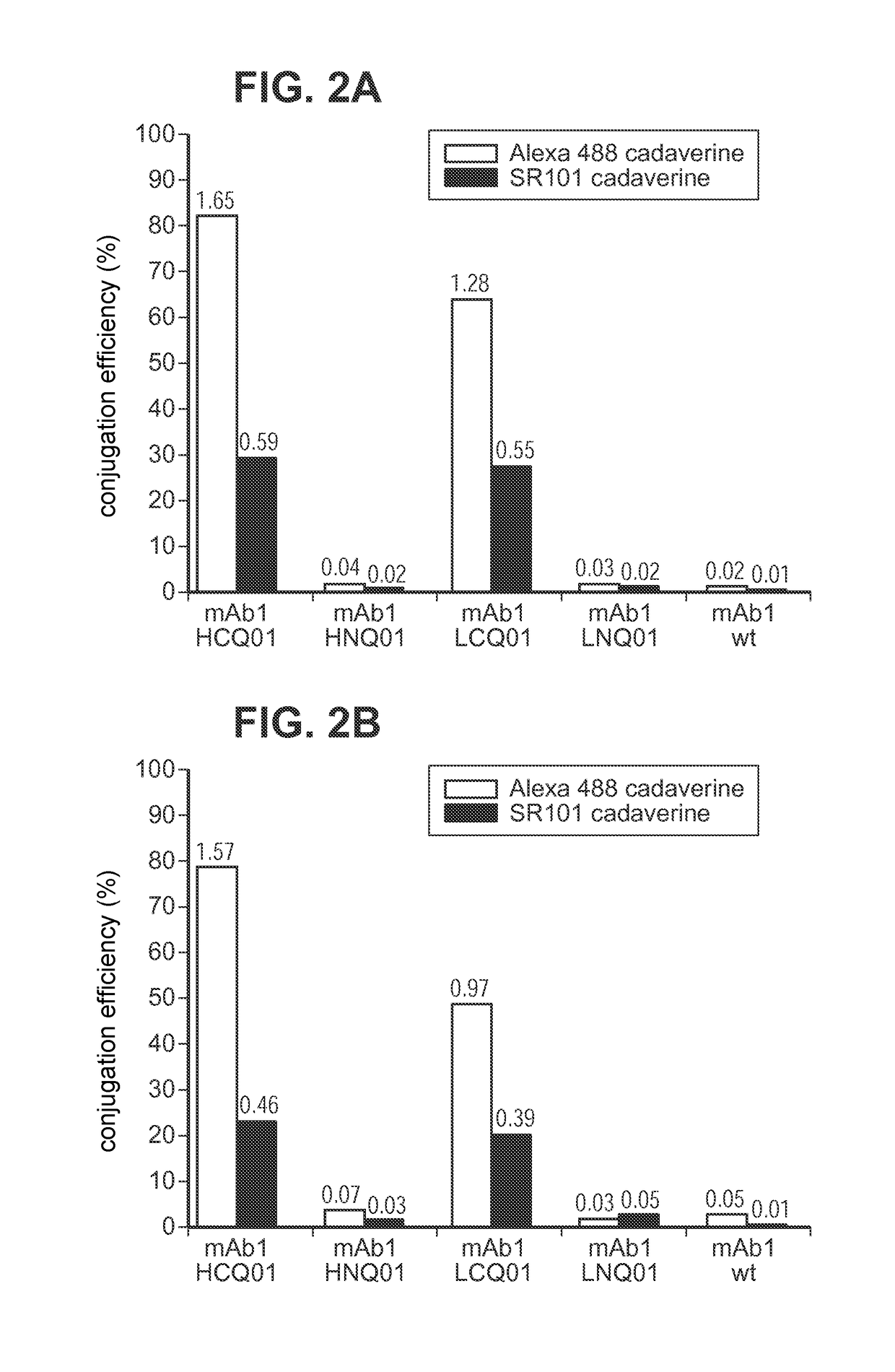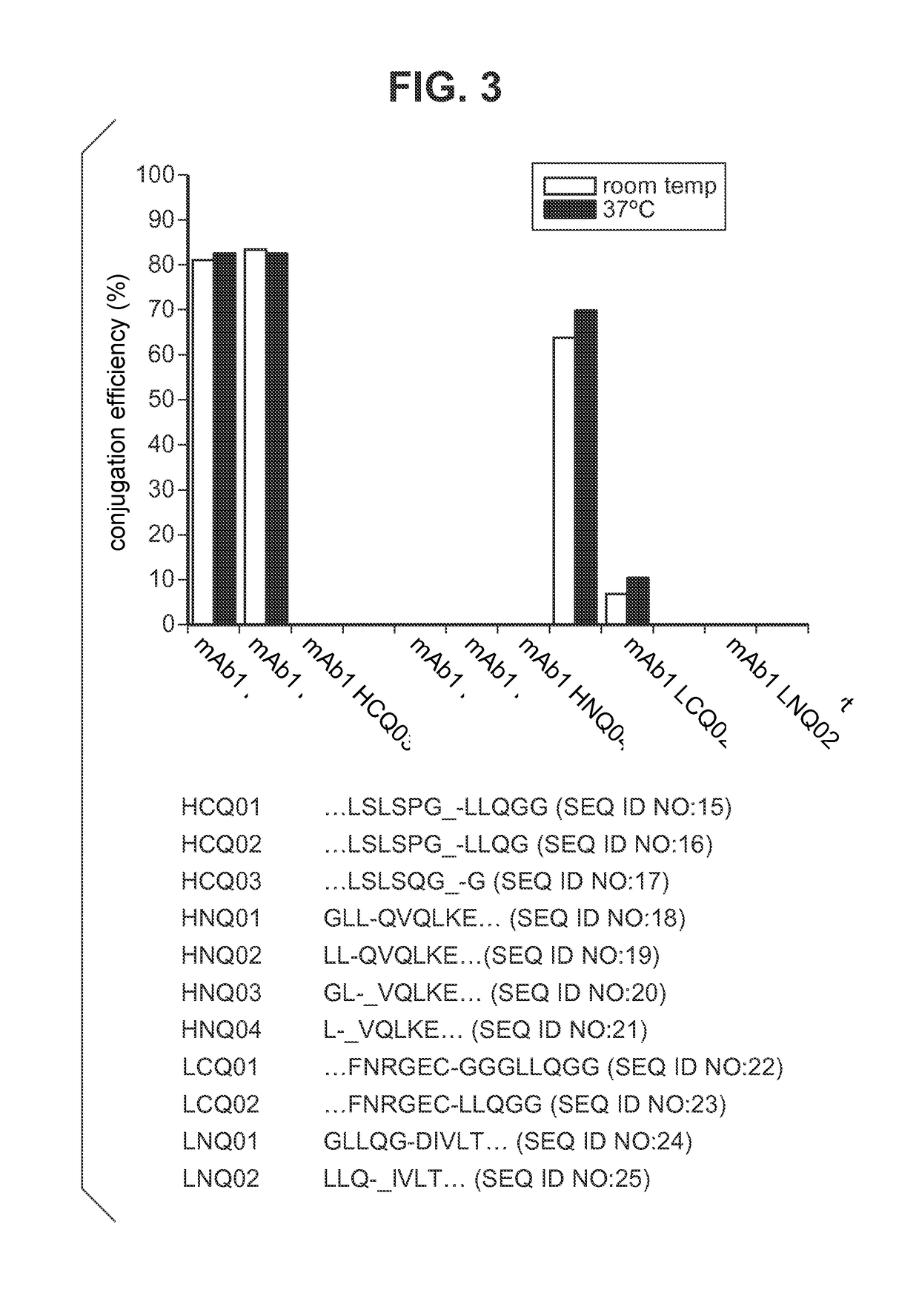Engineered polypeptide conjugates and methods for making thereof using transglutaminase
a technology of transglutaminase and polypeptide, which is applied in the field of engineered polypeptide conjugates, can solve the problems of complex process of expression and conjugation of engineered cysteine antibodies and antibody-drug conjugates, and the formation of inclusion bodies or incorrect disulfide bridges, and achieves the effect of increasing the conjugation efficiency of fc-containing polypeptides
- Summary
- Abstract
- Description
- Claims
- Application Information
AI Technical Summary
Benefits of technology
Problems solved by technology
Method used
Image
Examples
example 1
ific Antibody-Drug Conjugation Using a Transglutaminase
[0220]Antibody conjugation to a desired payload (drug or agent moiety) was achieved via microbial transglutaminase-catalyzed transamidation reaction between an antibody carrying a glutamine tag (Q-tag) at the carboxyl terminus of the heavy and / or light chains and an amine-containing derivative of the payload (imaging agent or cytotoxin) of choice.
[0221]In this transamidation reaction, the glutamine on the antibody acted as an acyl donor, and the amine-containing compound acted as an acyl acceptor (amine donor). Purified antibody in the concentration of 1.67-4.04 μM was incubated with a 20-100 M excess acyl acceptor, ranging between 167-404 μM, in the presence of 0.225-0.545% (w / v) Streptoverticillium mobaraense transglutaminase (ACTIVA™, Ajinomoto, Japan) in 150-900 mM NaCl, and 25 mM MES, HEPES [4-(2-hydroxyethyl)-1-piperazineethanesulfonic acid] or Tris HCl buffer at pH range 6.2-8.8. The reaction cond...
example 2
aminase Catalyzed Crosslinking of Bispecific Antibodies Using Different K-Tag and Q-Tag
Materials and Methods
[0233]IgG heterodimers (i.e., bispecific antibodies) were prepared by incubation of the two antibodies (either wild type IgG4 or IgG1 and IgG2 bispecific mutants) in PBS (Phosphate Buffered Saline) with 1-2 mM GSH (Glutathione) for 24 hours at 37° C. The heterodimers were crosslinked by incubation of the formed bispecific antibody with microbial transglutaminase. In the transamidation reaction, the introduced glutamine on the antibody acts as an acyl donor, and either lysine on the antibody, the lysine containing tags, or diamine compounds act as an acyl acceptor. Typically, 1.67-4.04 μM purified antibody is incubated with a 0.1-1.0% (w / v) Streptoverticillium mobaraense transglutaminase (ACTIVA, Ajinomoto, Japan) in 150-900 mM NaCl, and 25 mM MES (2-[N-morpholine]ethamine sulfonic acid), HEPES or Tris HCl buffer at pH range 6.2-8.8. In the case of crosslinking of two glutamine...
example 3
Cytotoxicity Assays
[0237]In vitro cytotoxicity assays were carried out using various antibodies, payloads (i.e., agent moieties), and amine donor units. For mAb2 (a chimeric IgG1 antibody), target expressing (A431, OVCAR3, BxPC3 and HT-29) or non-expressing (SW620) cells were seeded on white walled clear bottom plates at 2000 cells / well for 24 hours before treatment. Cells were treated with 4 fold serially diluted antibody-drug conjugates or free compounds (i.e., no antibody conjugated to the drug) in triplicates. Cell viability was determined by CellTiter-Glo® Luminescent Cell Viability Assay 96 (Promega, Madison Wis.) 96 hours after treatment. Relative cell viability was determined as percentage of untreated control. IC50 was calculated by Prism software. Table 6 shows the conjugation ratio and antibody IC50 in different cells using various antibody-drug conjugates and unconjugated drugs.
[0238]
TABLE 6A431OVCAR3BxPC3HT-29SW620Anti-Anti-Anti-Anti-Anti-bodyAnti-bodyAnti-bodyAnti-body...
PUM
| Property | Measurement | Unit |
|---|---|---|
| excitation wavelength | aaaaa | aaaaa |
| pH | aaaaa | aaaaa |
| pH | aaaaa | aaaaa |
Abstract
Description
Claims
Application Information
 Login to View More
Login to View More - R&D
- Intellectual Property
- Life Sciences
- Materials
- Tech Scout
- Unparalleled Data Quality
- Higher Quality Content
- 60% Fewer Hallucinations
Browse by: Latest US Patents, China's latest patents, Technical Efficacy Thesaurus, Application Domain, Technology Topic, Popular Technical Reports.
© 2025 PatSnap. All rights reserved.Legal|Privacy policy|Modern Slavery Act Transparency Statement|Sitemap|About US| Contact US: help@patsnap.com



